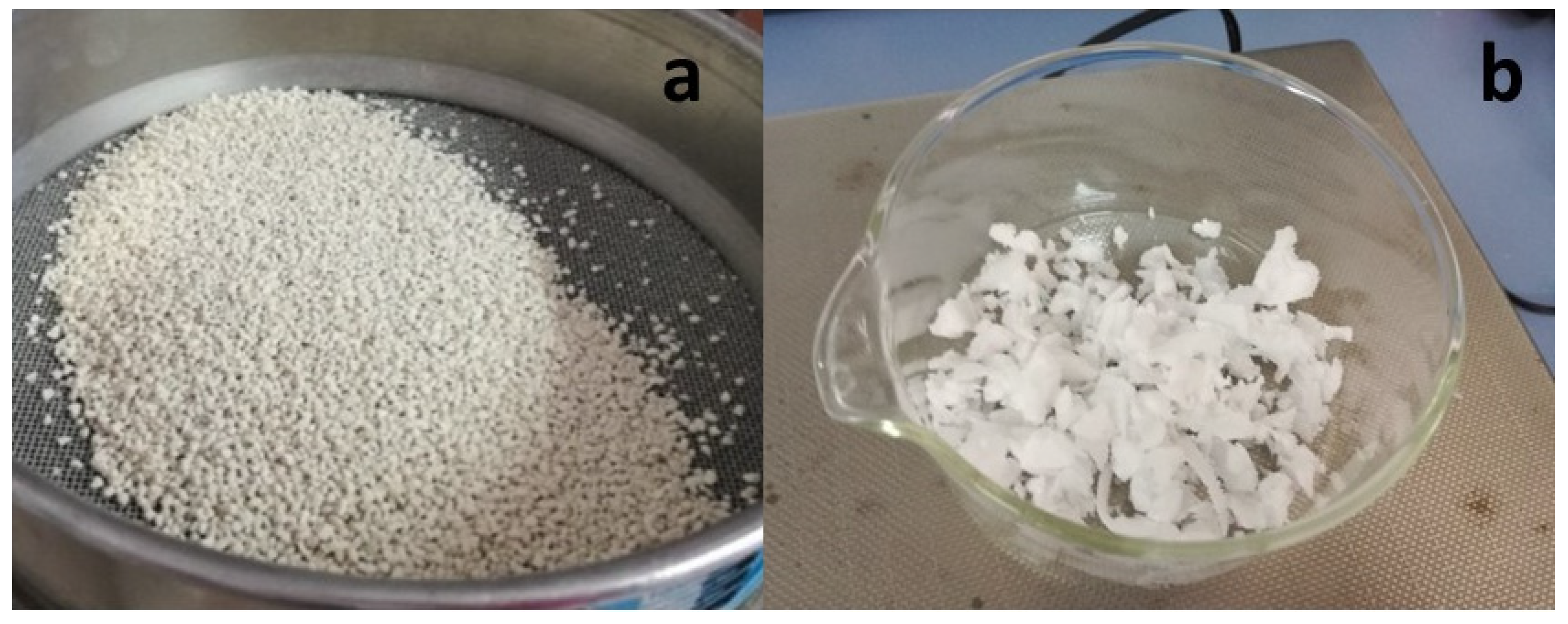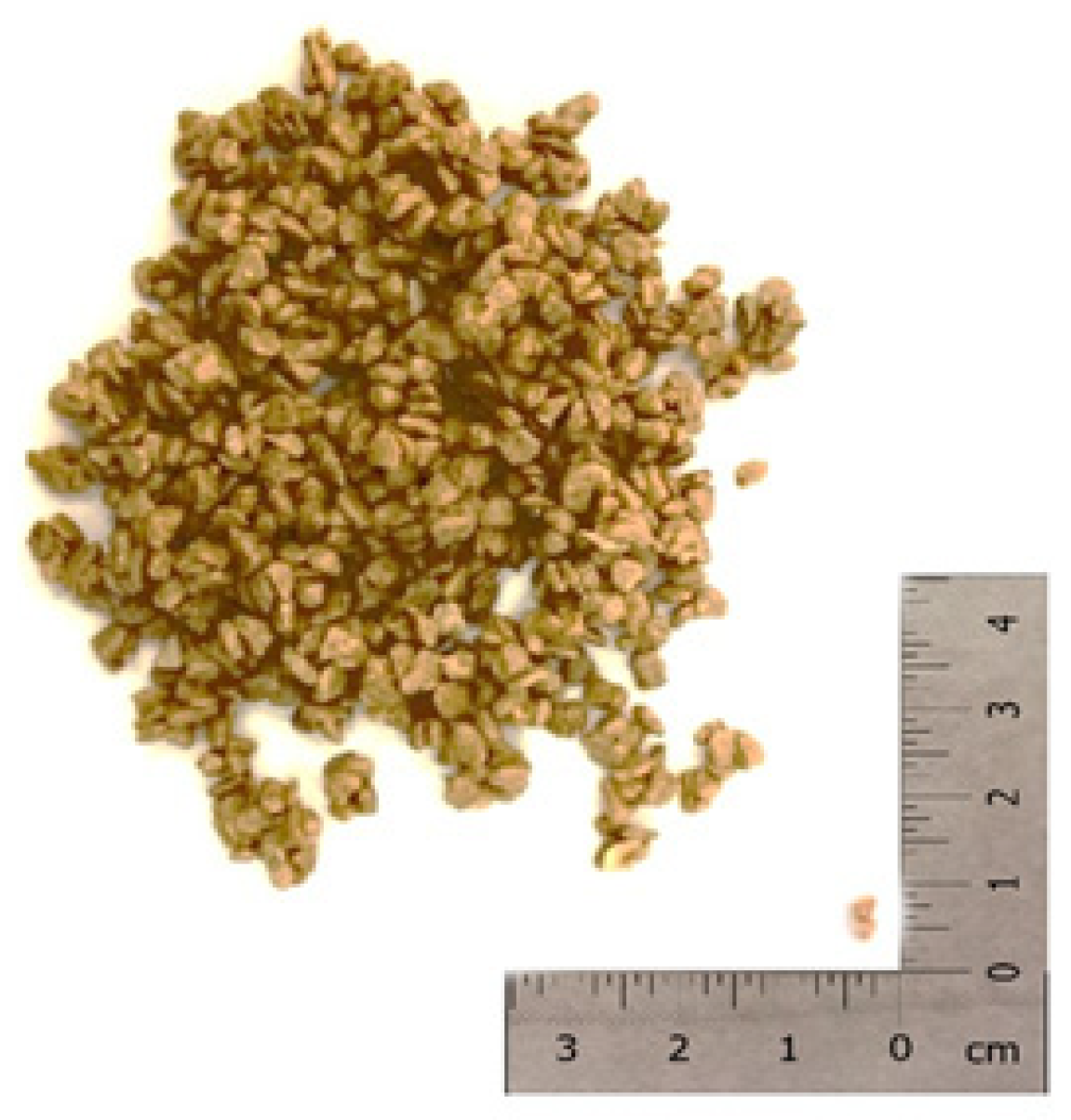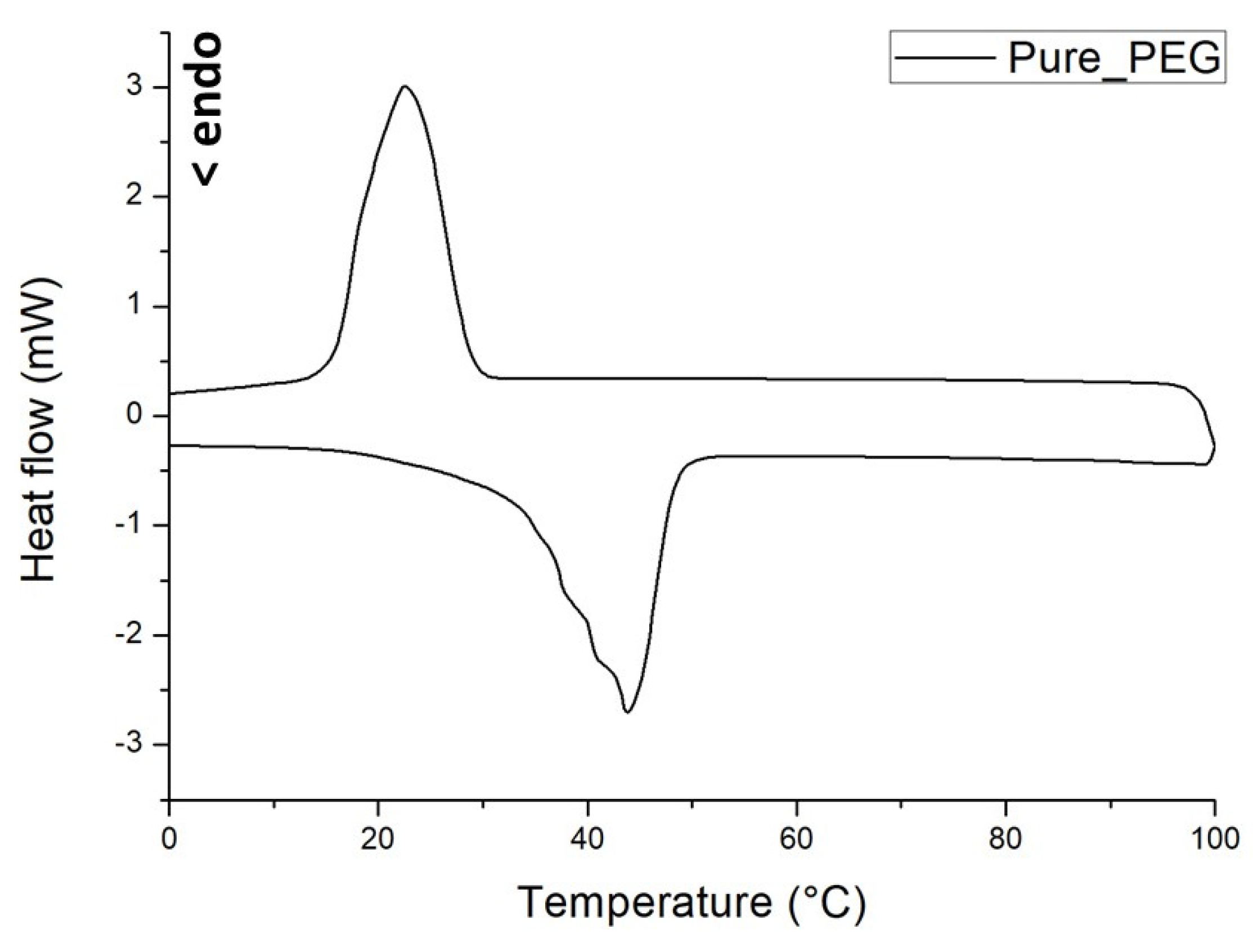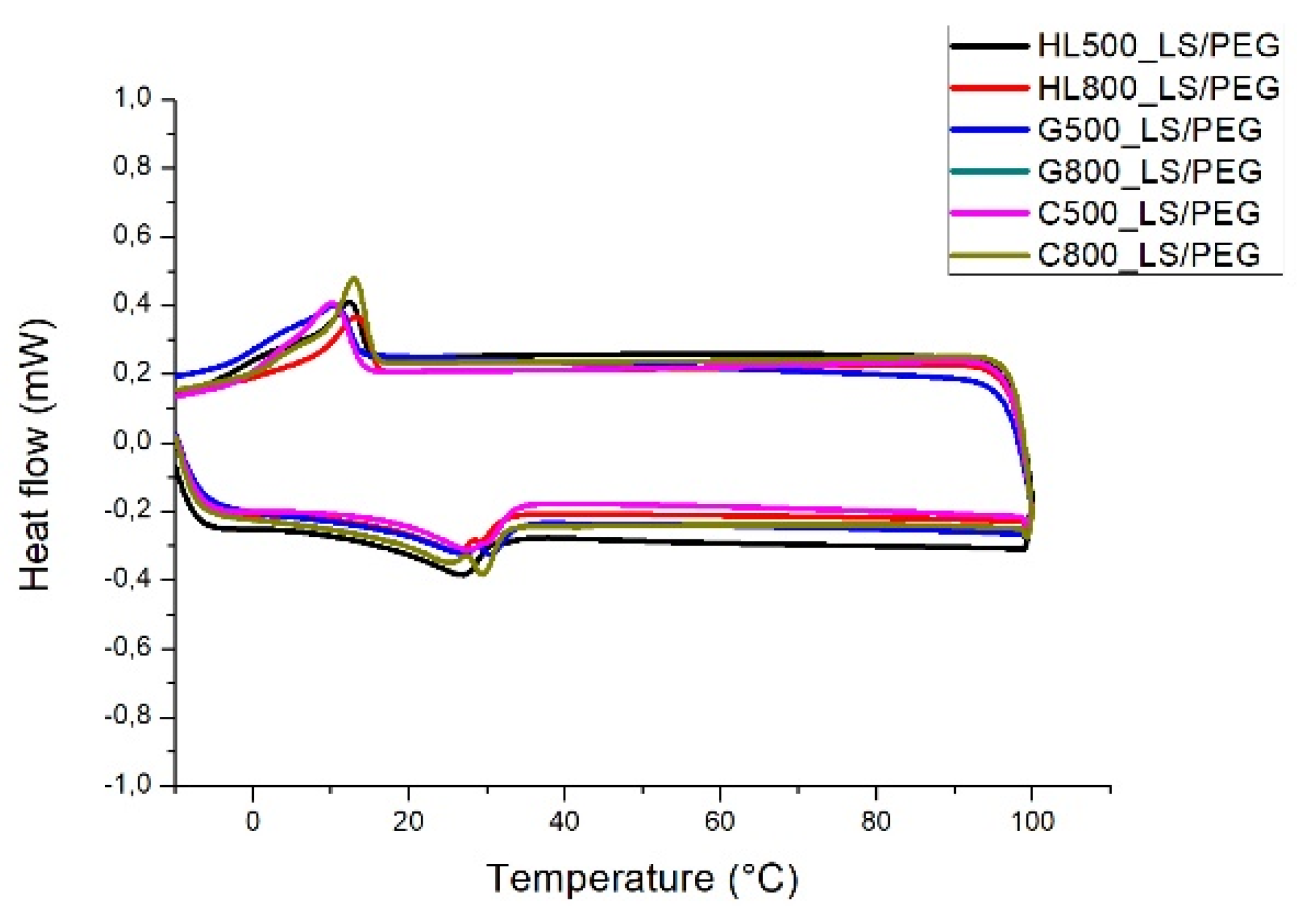Applications of Sustainable Polymer-Based Phase Change Materials in Mortars Composed by Different Binders
Abstract
:1. Introduction
2. Materials and Methods
2.1. Materials: LS/PEG Composite
2.2. Materials: Mortars and Their Manufacture
2.3. Methods and Test Procedures
3. Results and Discussion
3.1. Workability of Mortars
3.2. Results of DSC Analysis Performed on Mortars
3.3. Mechanical Properties of Mortars
4. Conclusions
Author Contributions
Funding
Acknowledgments
Conflicts of Interest
References
- Bilgen, S. Structure and Environmental Impact of Global Energy Consumption. Renew. Sustain. Energy Rev. 2014, 38, 890–902. [Google Scholar] [CrossRef]
- Cunha, S.; Aguiar, J.; Ferreira, V. Mortars with Incorporation of Phase Change Materials for Thermal Rehabilitation. Int. J. Arch. Herit. 2016, 1–10. [Google Scholar] [CrossRef]
- Munarim, U.; Ghisi, E. Environmental Feasibility of Heritage Buildings Rehabilitation. Renew. Sustain. Energy Rev. 2016, 58, 235–249. [Google Scholar] [CrossRef]
- Janarthanan, B.; Sagadevan, S. Thermal Energy Storage Using Phase Change Materials and Their Applications: A Review. Int. J. ChemTech Rse. 2015, 8, 250–256. [Google Scholar]
- Pomianowski, M.; Heiselberg, P.; Zhang, Y. Review of Thermal Energy Storage Technologies Based on PCM Application in Buildings. Energy Build. 2013, 67, 56–69. [Google Scholar] [CrossRef]
- Kalnæs, S.E.; Jelle, B.P. Phase Change Materials and Products for Building Applications: A State-Of-The-Art Review and Future Research Opportunities. Energy Build. 2015, 94, 150–176. [Google Scholar] [CrossRef]
- Zhang, P.; Xiao, X.; Ma, Z. A Review of the Composite Phase Change Materials: Fabrication, Characterization, Mathematical Modeling and Application to Performance Enhancement. Appl. Energy 2016, 165, 472–510. [Google Scholar] [CrossRef]
- Cui, Y.Q.; Riffat, S. Review on Phase Change Materials for Building Applications. Appl. Mech. Mater. 2011, 71, 1958–1962. [Google Scholar] [CrossRef]
- Madessa, H.B. A Review of the Performance of Buildings Integrated with Phase Change Material: Opportunities for Application in Cold Climate. Energy Procedia 2014, 62, 318–328. [Google Scholar] [CrossRef] [Green Version]
- Nkwetta, D.N.; Haghighat, F. Thermal Energy Storage with Phase Change Material—A State-Of-The Art Review. Sustain. Cities Soc. 2014, 10, 87–100. [Google Scholar] [CrossRef]
- Ogrodnik, P.; Zegardlo, B.; Szeląg, M. The Use of Heat-Resistant Concrete Made with Ceramic Sanitary Ware Waste for a Thermal Energy Storage. Appl. Sci. 2017, 7, 1303. [Google Scholar] [CrossRef]
- John, E.; Hale, M.; Selvam, P. Concrete as a Thermal Energy Storage Medium for Thermocline Solar Energy Storage Systems. Sol. Energy 2013, 96, 194–204. [Google Scholar] [CrossRef]
- Lu, S.; Li, Y.; Kong, X.; Pang, B.; Chen, Y.; Zheng, S.; Sun, L. A Review of PCM Energy Storage Technology Used in Buildings for the Global Warming Solution. In Energy Solutions to Combat Global Warming; Zhang, X., Dincer, I., Eds.; Springer International Publishing: Cham, Switzerland; Berlin, Germany, 2017; Volume 33, pp. 611–644. ISBN 978-3-319-26948-1. [Google Scholar]
- Memon, S.A. Phase Change Materials Integrated in Building Walls: A State of the Art Review. Renew. Sustain. Energy Rev. 2014, 31, 870–906. [Google Scholar] [CrossRef]
- Huang, X.; Alva, G.; Jia, Y.; Fang, G. Morphological Characterization and Applications of Phase Change Materials in Thermal Energy Storage: A Review. Renew. Sustain. Energy Rev. 2017, 72, 128–145. [Google Scholar] [CrossRef]
- Song, M.; Niu, F.; Mao, N.; Hu, Y.; Deng, S. Review on Building Energy Performance Improvement Using Phase Change Materials. Energy Build. 2018, 158, 776–793. [Google Scholar] [CrossRef]
- Kusama, Y.; Ishidoya, Y. Thermal Effects of a Novel Phase Change Material (PCM) Plaster Under Different Insulation and Heating Scenarios. Energy Build. 2017, 141, 226–237. [Google Scholar] [CrossRef]
- Frigione, M.; Lettieri, M.; Sarcinella, A. Phase Change Materials for Energy Efficiency in Buildings and Their Use in Mortars. Materials 2019, 12, 1260. [Google Scholar] [CrossRef]
- Aguayo, M.; Das, S.; Maroli, A.; Kabay, N.; Mertens, J.C.; Rajan, S.D.; Sant, G.; Chawla, N.; Neithalath, N. The Influence of Microencapsulated Phase Change Material (PCM) Characteristics on the Microstructure and Strength of Cementitious Composites: Experiments and Finite Element Simulations. Cem. Concr. Compos. 2016, 73, 29–41. [Google Scholar] [CrossRef]
- Coppola, L.; Coffetti, D.; Lorenzi, S. Cement-Based Renders Manufactured with Phase-Change Materials: Applications and Feasibility. Adv. Mater. Sci. Eng. 2016, 2016, 1–6. [Google Scholar] [CrossRef] [Green Version]
- Lecompte, T.; Le Bideau, P.; Glouannec, P.; Nortershäuser, D.; Le Masson, S. Mechanical and Thermo-Physical Behaviour of Concretes and Mortars Containing Phase Change Material. Energy Build. 2015, 94, 52–60. [Google Scholar] [CrossRef]
- Pavlik, Z.; Trnik, A.; Keppert, M.; Pavlikova, M.; Zumar, J.; Cerny, R. Experimental Investigation of the Properties of Lime-Based Plaster-Containing PCM for Enhancing the Heat-Storage Capacity of Building Envelopes. Int. J. Thermophys. 2014, 35, 767–782. [Google Scholar] [CrossRef]
- Kheradmand, M.; Abdollahnejad, Z.; Torgal, F.P. Mechanical Performance of Fly Ash Geopolymeric Mortars Containing Phase Change Materials. In Proceedings of the International Congress on Polymers in Concrete (ICPIC 2018); Taha, M.M.R., Ed.; Springer International Publishing: Berlin, Germany, 2018; pp. 211–216. [Google Scholar]
- Pacheco-Torgal, F.; Faria, J.; Jalali, S. Some Considerations about the Use of Lime–Cement Mortars for Building Conservation Purposes in Portugal: A Reprehensible Option or a Lesser Evil. Constr. Build. Mater. 2012, 30, 488–494. [Google Scholar] [CrossRef]
- Frigione, M.; Lettieri, M.; Sarcinella, A.; De Aguiar, J.B. Mortars with Phase Change Materials (PCM) and Stone Waste to Improve Energy Efficiency in Buildings. In International Congress on Polymers in Concrete (ICPIC 2018); Springer Science and Business Media LLC: Berlin, Germany, 2018; pp. 195–201. [Google Scholar]
- Frigione, M.; Lettieri, M.; Sarcinella, A.; De Aguiar, J.B. Sustainable Polymer-Based Phase Change Materials for Energy Efficiency in Buildings and Their Application in Aerial Lime Mortars. Constr. Build. Mater. 2020, 231, 117149. [Google Scholar] [CrossRef]
- Kou, Y.; Wang, S.; Luo, J.; Sun, K.; Zhang, J.; Tan, Z.; Shi, Q. Thermal Analysis and Heat Capacity Study of Polyethylene Glycol (PEG) Phase Change Materials for Thermal Energy Storage Applications. J. Chem. Thermodyn. 2019, 128, 259–274. [Google Scholar] [CrossRef]
- Andriani, G.F.; Walsh, N. Petrophysical and Mechanical Properties of Soft and Porous Building Rocks Used in Apulian Monuments (South Italy). Geol. Soc. London Spec. Publ. 2010, 333, 129–141. [Google Scholar] [CrossRef]
- Whiffen, T.R.; Riffat, S.B. A Review of PCM Technology for Thermal Energy Storage in the Built Environment: Part I. Int. J. Low Carbon Technol. 2013, 8, 147–158. [Google Scholar] [CrossRef]
- Kamali, S. Review of Free Cooling System Using Phase Change Material for Building. Energy Build. 2014, 80, 131–136. [Google Scholar] [CrossRef]
- European Committee for Standardization. EN 998-1: 2010: Specification for Mortar for Masonry-Part 1: Rendering and Plastering Mortar; CEN: Brussels, Belgium, 2010. [Google Scholar]
- Cunha, S.; Aguiar, J.; Ferreira, V.; Tadeu, A. Mortars Based in Different Binders with Incorporation of Phase-Change Materials: Physical and Mechanical Properties. Eur. J. Environ. Civ. Eng. 2015, 19, 1–18. [Google Scholar] [CrossRef]
- European Committee for Standardization (CEN). EN 1015-3 (2004), Methods of Test for Mortar for Mansonry-Part 3: Determination of Consistence of Fresh Mortar (by flow table); CEN: Brussels, Belgium, 2004. [Google Scholar]
- European Committee for Standardization (CEN). EN 1015-11 (1999), Methods of Test for Mortar for Masonry-Part 11: Determination of Flexural and Compressive Strength of Hardened Mortar; CEN: Brussels, Belgium, 1999. [Google Scholar]
- Snoeck, D.; Priem, B.; Dubruel, P.; De Belie, N. Encapsulated Phase-Change Materials as Additives in Cementitious Materials to Promote Thermal Comfort in Concrete Constructions. Mater. Struct. 2016, 49, 225–239. [Google Scholar] [CrossRef]
- Cunha, S.; Lucas, S.; Aguiar, J.; Ferreira, V.; Bragança, L. Influence of Incorporation Phase Change Materials, PCM, Granulates on Workability, Mechanical Strenght and Aesthetical Appearence of Lime and Gypsum Mortars. Archit. Civ. Eng. Environ. 2013, 6, 39–48. [Google Scholar]
- Karaman, S.; Karaipekli, A.; Sarı, A.; Biçer, A. Polyethylene Glycol (PEG)/Diatomite Composite as a Novel Form-Stable Phase Change Material for Thermal Energy Storage. Sol. Energy Mater. Sol. Cells 2011, 95, 1647–1653. [Google Scholar] [CrossRef]
- Qian, T.; Li, J.; Min, X.; Deng, Y.; Guan, W.; Ma, H. Polyethylene Glycol/Mesoporous Calcium Silicate Shape-Stabilized Composite Phase Change Material: Preparation, Characterization, and Adjustable Thermal Property. Energy 2015, 82, 333–340. [Google Scholar] [CrossRef]
- Zhang, Z.; Shi, G.; Wang, S.; Fang, X.; Liu, X. Thermal Energy Storage Cement Mortar Containing n-Octadecane/Expanded Graphite Composite Phase Change Material. Renew. Energy 2013, 50, 670–675. [Google Scholar] [CrossRef]
- Li, M.; Wu, Z.; Tan, J. Heat Storage Properties of the Cement Mortar Incorporated with Composite Phase Change Material. Appl. Energy 2013, 103, 393–399. [Google Scholar] [CrossRef]
- Shadnia, R.; Zhang, L.; Li, P. Experimental Study of Geopolymer Mortar with Incorporated PCM. Constr. Build. Mater. 2015, 84, 95–102. [Google Scholar] [CrossRef]
- Min, X.; Fang, M.; Huang, Z.; Liu, Y.; Huang, Y.; Wen, R.; Qian, T.; Wu, X. Enhanced Thermal Properties of Novel Shape-Stabilized PEG Composite Phase Change Materials with Radial Mesoporous Silica Sphere for Thermal Energy Storage. Sci. Rep. 2015, 5, 12964. [Google Scholar] [CrossRef]
- Deng, Y.; He, M.; Li, J.; Yang, Z. Polyethylene Glycol-Carbon Nanotubes/Expanded Vermiculite Form-Stable Composite Phase Change Materials: Simultaneously Enhanced Latent Heat and Heat Transfer. Polymers 2018, 10, 889. [Google Scholar] [CrossRef]
- Wang, Z.; Su, H.; Zhao, S.; Zhao, N. Influence of Phase Change Material on Mechanical and Thermal Properties of Clay Geopolymer Mortar. Constr. Build. Mater. 2016, 120, 329–334. [Google Scholar] [CrossRef]
- Wang, P.; Li, N.; Zhao, C.S.; Wu, L.Y.; Han, G.B. A Phase Change Storage Material that May be Used in the Fire Resistance of Building Structure. Procedia Eng. 2014, 71, 261–264. [Google Scholar] [CrossRef] [Green Version]
- Ramakrishnan, S.; Wang, X.; Sanjayan, J.; Wilson, J. Thermal Performance Assessment of Phase Change Material Integrated Cementitious Composites in Buildings: Experimental and Numerical Approach. Appl. Energy 2017, 207, 654–664. [Google Scholar] [CrossRef]
- Liu, F.; Wang, J.; Qian, X. Integrating Phase Change Materials into Concrete Through Microencapsulation Using Cenospheres. Cem. Concr. Compos. 2017, 80, 317–325. [Google Scholar] [CrossRef]
- Li, T.; Yuan, Y.; Zhang, N. Thermal Properties of Phase Change Cement Board with Capric Acid/Expanded Perlite Form-Stable Phase Change Material. Adv. Mech. Eng. 2017, 9. [Google Scholar] [CrossRef]
- Yang, H.; Feng, L.; Wang, C.; Zhao, W.; Li, X. Confinement Effect of SiO2 Framework on Phase Change of PEG in Shape-Stabilized PEG/SiO2 Composites. Eur. Polym. J. 2012, 48, 803–810. [Google Scholar] [CrossRef]
- Gao, C.F.; Wang, L.P.; Li, Q.F.; Wang, C.; Nan, Z.D.; Lan, X.Z. Tuning Thermal Properties of Latent Heat Storage Material Through Confinement in Porous Media: The Case of (1-CnH2n+1NH3)2ZnCl4 (n = 10 and 12). Sol. Energy Mater. Sol. Cells 2014, 128, 221–230. [Google Scholar] [CrossRef]
- Wang, C.; Li, Q.; Wang, L.; Lan, X. Phase Transition of Neopentyl Glycol in Nanopores for Thermal Energy Storage. Thermochim. Acta 2016, 632, 10–17. [Google Scholar] [CrossRef]
- Deng, S.; Wang, D.; Wang, X.; Wei, Y.; Waterhouse, G.I.; Lan, X.Z. Effect of Nanopore Confinement on the Thermal and Structural Properties of Heneicosan. Thermochim. Acta 2018, 664, 57–63. [Google Scholar] [CrossRef]
- Sarı, A. Thermal Energy Storage Characteristics of Bentonite-Based Composite PCMs with Enhanced Thermal Conductivity as Novel Thermal Storage Building Materials. Energy Convers. Manag. 2016, 117, 132–141. [Google Scholar] [CrossRef]
- Radhakrishnan, R.; Gubbins, K.E. Free Energy Studies of Freezing in Slit Pores: An Order-Parameter Approach Using Monte Carlo Simulation. Mol. Phys. 1999, 96, 1249–1267. [Google Scholar] [CrossRef]
- Cunha, S.; Aguiar, J.; Pacheco-Torgal, F. Effect of Temperature on Mortars with Incorporation of Phase Change Materials. Constr. Build. Mater. 2015, 98, 89–101. [Google Scholar] [CrossRef]
- Cunha, S.; Aguiar, J.; Ferreira, V.; Tadeu, A.; Garbacz, A. Mortars with Phase Change Materials-Part I: Physical and Mechanical Characterization. Key Eng. Mater. 2014, 634, 22–32. [Google Scholar] [CrossRef]
- Pavlik, Z.; Trnik, A.; Ondruska, J.; Keppert, M.; Pavlikova, M.; Volfova, P.; Kaulich, V.; Cerny, R. Apparent Thermal Properties of Phase-Change Materials: An Analysis Using Differential Scanning Calorimetry and Impulse Method. Int. J. Thermophys. 2013, 34, 851–864. [Google Scholar] [CrossRef]
- Cunha, S.; Aguiar, J.; Zalegowski, K.; Garbacz, A.; Soares, P.; Azevedo, J.; Ferreira, V.; Tadeu, A. Sustainable Mortars with Incorporation of Microencapsulated Phase Change Materials. Adv. Mater. Res. 2015, 1129, 621–628. [Google Scholar] [CrossRef]
- Silva, N.; Aguiar, J.B.; Bragança, L.M.; Freire, T.; Cardoso, I. Properties of Gypsum-PCM Based Mortars for Interior Plastering of Construction Systems. Mater. Sci. Forum 2008, 587, 913–917. [Google Scholar] [CrossRef]
- Jaworski, M.; Abeid, S. Thermal Conductivity of Gypsum with Incorporated Phase Change Material (PCM) for Building Applications. J. Power Technol. 2011, 91, 49–53. [Google Scholar]
- Cunha, S.; Aguiar, J.B.; Ferreira, V.M.; Tadeu, A. Influence of the Type of Phase Change Materials Microcapsules on the Properties of Lime-Gypsum Thermal Mortars: Influence of the Type of Phase Change Materials Microcapsules. Adv. Eng. Mater. 2014, 16, 433–441. [Google Scholar] [CrossRef]
- Djamai, Z.I.; Salvatore, F.; Larbi, A.S.; Cai, G.; El Mankibi, M. Multiphysics Analysis of Effects of Encapsulated Phase Change Materials (PCMs) in Cement Mortars. Cem. Concr. Res. 2019, 119, 51–63. [Google Scholar] [CrossRef]





| System | Binder/Content | Aggregates | SP | Water Saturation | Water | Water/Binder | |
|---|---|---|---|---|---|---|---|
| LS | PEG Content | ||||||
| HL500_LS | Hydraulic Lime/500 | 1480 | 0 | 15 | 370 | 300 | 0.60 |
| HL500_LS/PEG | Hydraulic Lime/500 | 1678 | 386 | 15 | 0 | 350 | 0.70 |
| G500_LS | Gypsum/500 | 1454 | 0 | 15 | 366 | 325 | 0.65 |
| G500_LS/PEG | Gypsum/500 | 1645 | 378 | 15 | 0 | 375 | 0.75 |
| C500_LS | Cement/500 | 1392 | 0 | 15 | 350 | 340 | 0.68 |
| C500_LS/PEG | Cement/500 | 1790 | 412 | 15 | 0 | 350 | 0.70 |
| HL800_LS | Hydraulic Lime/800 | 1092 | 0 | 15 | 275 | 320 | 0.40 |
| HL800_LS/PEG | Hydraulic Lime/800 | 1729 | 398 | 15 | 0 | 375 | 0.47 |
| G800_LS | Gypsum/800 | 1169 | 0 | 15 | 294 | 320 | 0.40 |
| G800_LS/PEG | Gypsum/800 | 1472 | 339 | 15 | 0 | 340 | 0.43 |
| C800_LS | Cement/800 | 1070 | 0 | 15 | 269 | 296 | 0.37 |
| C800_LS/PEG | Cement/800 | 1347 | 310 | 15 | 0 | 360 | 0.45 |
| System | Workability (mm) |
|---|---|
| HL500_LS | 170 ± 2 |
| HL500_LS/PEG | 177 ± 3 |
| G500_LS | 160 ± 1 |
| G500_LS/PEG | 180 ± 3 |
| C500_LS | 160 ± 1 |
| C500_LS/PEG | 160 ± 1 |
| HL800_LS | 165 ± 2 |
| HL800_LS/PEG | 175 ± 2 |
| G800_LS | 160 ± 1 |
| G800_LS/PEG | 160 ± 1 |
| C800_LS | 160 ± 1 |
| C800_LS/PEG | 178 ± 3 |
| System | PEG Content (%) | Onset (°C) | Endset (°C) | Tm (°C) | ΔHm (J/g) | ΔHm Theor (J/g) | |
| Heating Stage | PEG | 100 | 36.4 ± 0.6 | 50.2 ± 0.3 | 42.8 ± 1.1 | 129.3 ± 1.2 | --- |
| LS/PEG | 23 | 12.4 ± 0.5 | 50.2 ± 0.8 | 39.3 ± 0.7 | 27.7 ± 0.9 | 29.7 | |
| HL500_LS/PEG | 15.2 | 9.7 ± 0.4 | 37.9 ± 0.6 | 26.9 ± 0.7 | 6.8 ± 1.1 | 19.7 | |
| HL800_LS/PEG | 13.6 | 2.2 ± 1.0 | 41.8 ± 1.1 | 26.0 ± 0.8 | 7.9 ± 0.9 | 17.6 | |
| G500_LS/PEG | 14.9 | 3.5 ± 0.4 | 42.8 ± 0.2 | 30.4 ± 0.4 | 8.5 ± 0.9 | 19.3 | |
| G800_LS/PEG | 12.9 | 2.7 ± 0.5 | 35.9 ± 0.7 | 28.9 ± 1.0 | 7.8 ± 1.2 | 16.7 | |
| C500_LS/PEG | 15.5 | 4.3 ± 1.1 | 38.4 ± 0.7 | 27.6 ± 0.3 | 9.0 ± 1.3 | 20.0 | |
| C800_LS/PEG | 12.3 | 3.4 ± 0.1 | 36.3 ± 0.1 | 30.0 ± 0.3 | 7.7 ± 0.2 | 15.9 | |
| System | PEG Content (%) | Endset (°C) | Onset (°C) | Tc (°C) | ΔHc (J/g) | ΔHc Theor (J/g) | |
| Cooling Stage | PEG | 100 | 18.3 ± 1.1 | 26.7 ± 1.1 | 23.6 ± 1.2 | 129.8 ± 0.8 | --- |
| LS/PEG | 23 | 3.7 ± 0.1 | 28.8 ± 0.3 | 19.4 ± 0.2 | 28.6 ± 0.1 | 38.6 | |
| HL500_LS/PEG | 15.2 | 0.4 ± 0.5 | 17.6 ± 0.3 | 12.5 ± 0.4 | 6.2 ± 1.1 | 25.5 | |
| HL800_LS/PEG | 13.6 | 1.6 ± 0.4 | 18.9 ± 0.8 | 13.5 ± 0.2 | 6.0 ± 0.7 | 22.8 | |
| G500_LS/PEG | 14.9 | −1.1 ± 0.6 | 19.2 ± 0.7 | 10.6 ± 0.8 | 7.4 ± 0.9 | 25.0 | |
| G800_LS/PEG | 12.9 | 0.6 ± 0.9 | 16.9 ± 1.0 | 10.8 ± 0.7 | 7.5 ± 1.2 | 21.7 | |
| C500_LS/PEG | 15.5 | 0.2 ± 0.6 | 19.2 ± 0.7 | 10.3 ± 0.3 | 8.8 ± 1.2 | 26.0 | |
| C800_LS/PEG | 12.3 | −1.1 ± 0.2 | 16.7 ± 0.2 | 10.8 ± 0.3 | 8.7 ± 0.4 | 20.6 |
| System | Flexural Strength (MPa) | Compressive Strength (MPa) |
|---|---|---|
| HL500_LS | 1.1 ± 0.3 | 2.8 ± 0.8 [CSII]a |
| HL500_LS/PEG | 0.1 ± 0.1 | 0.4 ± 0.1 [CSI] a |
| G500_LS | 3.2 ± 0.2 | 4.8 ± 0.2 [CSII] a |
| G500_LS/PEG | 0.5 ± 0.1 | 0.4 ± 0.2 [CSI] a |
| C500_LS | 5.8 ± 0.3 | 20.5 ± 0.4 [CSIV] a |
| C500_LS/PEG | 1.0 ± 0.2 | 1.1 ± 0.2 [CSI] a |
| HL800_LS | 2.8 ± 0.5 | 17.0 ± 0.2 [CSIV] a |
| HL800_LS/PEG | 0.4 ± 0.1 | 1.5 ± 0.1 [CSI/CSII] a |
| G800_LS | 4.1 ± 0.2 | 16.4 ± 0.6 [CSIV] a |
| G800_LS/PEG | 1.6 ± 0.2 | 3.3 ± 0.3 [CSII] a |
| C800_LS | 9.2 ± 0.9 | 26.3 ± 0.4 [CSIV] a |
| C800_LS/PEG | 1.9 ± 0.3 | 3.4 ± 0.8 [CSII] a |
© 2019 by the authors. Licensee MDPI, Basel, Switzerland. This article is an open access article distributed under the terms and conditions of the Creative Commons Attribution (CC BY) license (http://creativecommons.org/licenses/by/4.0/).
Share and Cite
Frigione, M.; Lettieri, M.; Sarcinella, A.; Barroso de Aguiar, J.L. Applications of Sustainable Polymer-Based Phase Change Materials in Mortars Composed by Different Binders. Materials 2019, 12, 3502. https://doi.org/10.3390/ma12213502
Frigione M, Lettieri M, Sarcinella A, Barroso de Aguiar JL. Applications of Sustainable Polymer-Based Phase Change Materials in Mortars Composed by Different Binders. Materials. 2019; 12(21):3502. https://doi.org/10.3390/ma12213502
Chicago/Turabian StyleFrigione, Mariaenrica, Mariateresa Lettieri, Antonella Sarcinella, and José Luìs Barroso de Aguiar. 2019. "Applications of Sustainable Polymer-Based Phase Change Materials in Mortars Composed by Different Binders" Materials 12, no. 21: 3502. https://doi.org/10.3390/ma12213502








